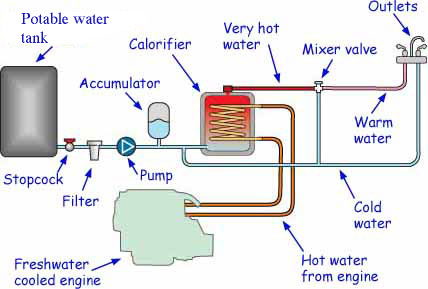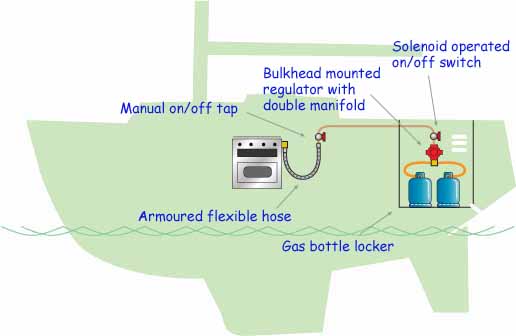- Home
- Choosing Accessories
- Boat Fridge
Don't Lose Your Cool with
Your Boat Fridge
It's often said that a top-opening boat fridge is more efficient than the front-opening type, because the cold doesn't 'fall out' when you take the lid off. True, but in my experience, whatever you need will be at the bottom, which means that half the stuff will have to come out before you can get at it.
Hot arms will displace the cold air and the stuff you've taken out will start to cool. In a front opening fridge, all the goodies are on shelves - easy to find and remove, so the door can quickly be closed.
I've not done the experiment, but I'll bet there's not much in it.
What is important is the quality and thickness of the insulation - at least 100mm of it - and the condition of the seal at the lid or door.
Either way, next time your grab a cool beer from your boat fridge, spare a thought for Robert Boyle who started it all back in 1662. Boyle recognised that if you mess around with the pressure and volume of a gas, its temperature will change - and that explains a lot of what goes on inside a fridge.
How Does A Boat Fridge Work?
The component parts of a boat fridge are a compressor, a condenser, an expansion valve and a cold plate. They work together to produce the following cycle of events:~
- The compressor compresses the refrigerant gas, reducing its volume and thereby raises its temperature, and pumps it along to the condenser.
- The condenser allows the refrigerant to dissipate the heat arising from the change in pressure.
- As it cools, the refrigerant condenses into liquid form and flows through the expansion valve.
- Here, the liquid refrigerant flows from a high pressure zone to low pressure zone, causing it to expand, vaporise and cool rapidly as it enters the cold plate.
- The coils inside the cold plate allow the refrigerant to absorb heat from the surrounding air, which is of course the inside of the boat fridge.
- The heat-bearing gas returns to the compressor and the cycle is repeated, further lowering the temperature of the boat fridge.
- When the temperature has dropped to the temperature set on the thermostat, the power to the compressor is turned off until such time as it has fallen to the 'start-up' temperature.
The system performance depends on the characteristics of the individual components, some of which are more suited for certain applications than others.
The Main Components of a Boat Fridge...
The Compressor
This is either powered by the boat's electrical system or driven by a belt from the main engine. Electrically powered compressors are normally of the diaphragm type, although very large units may be of a piston design.
This latter type, resembling a reciprocating engine, is more costly to manufacture but can be stripped and serviced by a competent mechanic, whereas the diaphragm type is almost invariably a sealed unit which must be replaced when it fails.
Due to their compactness, efficiency and quiet operation, nearly all proprietary 'packaged units' incorporate a diaphragm compressor. But piston or diaphragm, both types have a healthy appetite for electricity.
Engine driven versions, developed from car air-conditioning units, are engaged through an electromagnetic clutch, either automatically or simply by throwing a switch. They're very powerful and of course make no demand (other than a few milliamps for the thermostat) on the boat's electrical system.
But they do depend on running the main engine - typically an hour a day in a well set up system - which, on a sailing vessel, you may not always want to do.
The Condenser
This, a heat exchanger, will be one of two types - air cooled or seawater cooled.
Air cooled units are the simpler, more elegant solution and if installed below the waterline where the bilge air is at a similar temperature to the sea, they can be remarkably efficient - particularly so if a steady stream of cool air is wafted over them by a small fan.
But they can struggle a bit in hot climates where the difference between the ambient air temperature and that required inside the fridge may not be enough to dissipate the heat in the refrigerant gas. In these conditions, and most definitely if the cooling unit is installed in the engine room, a seawater type will be required.
A circulation pump draws in cooling water from outside the boat and, water being a much better conductor of heat than air, will carry away the heat more effectively.
An innovative approach by one manufacture manages to achieve seawater cooling without an electrically driven pump. A special skin fitting replaces the one normally fitted at the galley sink. This contains a spiral heat exchanger, through which the refrigerant gas passes transferring its heat to the seawater.
The slightest movement of the boat, even when tied-up alongside, is enough to pump away the heat. Clever stuff.
The Cold Plate
Again there are two types - the basic evaporator plate and the cold storage 'eutectic' plate.
The basic evaporator plate cools down quickly but equally quickly, warms up again. Consequently the thermostat will be regularly kicking the compressor in and out - a 'constant cycling' system. In hot climates the compressor may be running for 45 minutes or so in every hour, so the current drain will be high.
The cold storage 'eutectic' plate differs from the basic evaporator plate in that the coils are immersed in a liquid that freezes and melts at minimum temperature - a 'eutectic' liquid. This takes a bigger effort to cool the plate down, normally done in one hit by an oversized compressor, but it then retains its 'cool' for longer, gradually dispensing through a state of being frozen solid to partially thawed out.
Clearly this is the type of cold plate to use with an engine driven compressor, and if using the Automatic Start-Up system described below.
System Management
The Automatic Start-Up (ASU) system senses when surplus electrical energy is available, either from the alternator, solar panels or wind generator.
It then speeds up the compressor to rapidly freeze the eutectic liquid in the cold plate and keeps it frozen until surplus energy is no longer available, at which point it stops the compressor until either:~
- the cold plate falls to a predetermined temperature, whereon the compressor restarts in a low speed, low current mode to maintain the temperature at that level, or
- more surplus energy becomes available, whereon it restarts the compressor in high speed mode, freezing down the cold plate again.
Recent Articles
-
Wauquiez Gladiateur 33 for Sale
Apr 10, 24 05:40 AM
'Kesh', my Wauquiez Gladiateur 33 is only for sale because we've decided to go for a larger sailboat. She currently berthed in Florida, USA. -
'Cabo Frio', a Catalina Morgan 43 for sale
Apr 01, 24 08:35 AM
This Catalina Morgan 43 is for sale at a very reasonable price. She offers up to 7 berths in 2 cabins + saloon. There is full 6'5" standing headroom and good ventilation throughout. -
Live Aboard Boats For Sale
Mar 30, 24 07:02 PM
Ready to live the dream? Then browsing through this listing of live aboard boats for sale might just get you on your way...















